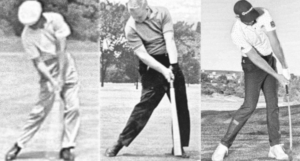
The Lateral Slide in Golf – Why It’s a Game Changer
There are different styles of golf swings that you can perform, but if you are into using the swing arc as your engine (like most golfers do), then you need to use the lateral slide in golf to your advantage.
80% of all modern tour players and close to 100% of all historic great golfers have had a lateral slide of somewhere between 5–20 cm from the end of the backswing to somewhere in the beginning of the downswing. It doesn’t really matter if you’re into The Golfing Machine, Stack and Tilt, MORAD, or more traditional swing arc techniques (like what I’m teaching)—basically, all protocols require that you move onto your lead side.
The only real exception is the centered, more baseball-like sling motion used by some modern players. If that’s your style, then this article may be less relevant to you. In that case, I’d recommend this great article by Kelvin Miyahira here.
By the way, you’ve probably heard that you should “hit from the ground up,” and as vague as this statement is, lateral motion actually makes it possible.
Let’s dig in.
Loading the Power System with Momentum
When you intentionally move toward the target, you supercharge the system with passive momentum. In other words, you generate more power effortlessly, without actively trying to do so.
And it gets even better.
Lateral Slide Secures The Low Point and….
One of the biggest challenges in golf is naturally bottoming out your club too early. This leads to various faulty behaviors, such as pushing the hands toward the target and being forced to stand up out of the shot. Failing to control the low point also creates a more subtle disadvantage—you instinctively take “off speed” because you subconsciously fear hitting the ball fat.
By incorporating a lateral slide, you shift your low point (where your club bottoms out) closer to the target, essentially reversing the issues mentioned above.
Impact Conditions affected by Lateral Slide
All else being equal, a more lateral slide position gives you slightly more steepness in the strike and encourages a path that comes more from the inside.
But the body naturally reacts to this by allowing more space for your arms together with the ability to release more centrifugal force, which efficiently shallows out the path while still coming from the inside.
Being shallow and from the inside is ideal because it opens the door to golf’s most sought-after trait—rotation. Rotation adds consistency, helps bring the path slightly more from the outside, and introduces just the right amount of steepness.
Pretty awesome marriage, right?
Potential for Old School Goodness
Everything I’ve discussed above also paves the way for replicating what the old greats did. Since the lateral slide moves the low point forward and creates steepness, it allows you to tap into how the legends of the game moved through the ball.
They exited the club much more vertically than what most modern golf instruction teaches. In simple terms, they paired very shallow club conditions with steep body positions.
Just think about Bubba Watson for a second—you can see the concept in action. Hands reaching toward the sky while still delivering the club 10 degrees from the inside with a wedge or shaping a 40-yard slice with shallow impact conditions.
That was a tough pill to swallow… A less extreme version of this is basically what I teach in my FMM swing style but that’s another story.
Too Much Lateral Slide?
As with everything in golf, balance is key to performing proper, solid swings. The lateral slide, if done excessively, can actually lock your lead hip socket and make it impossible to use your hips effectively through the ball. This occurs when your hips are in a trail side pelvic tilt, which is problematic because it restricts your follow-through rotation. If you ever feel that your follow-through is limited, it’s likely because you’ve shifted too much laterally or tilted the pelvis slightly.
Hitting from the Ground Up – Possible through Lateral Slide
As mentioned at the beginning of this article, you can start utilizing the ground much more effectively by incorporating lateral movement. I’ve never intentionally “hit from the ground up” in my life, but I’ve felt countless times that having a solid foundation is far better than losing connection with your feet.
In other words, the lateral slide builds pressure into your feet, which you then use to stand up and extend out of the shot. And to tie it all together—extension is what allows you to rotate naturally, without having to consciously think about it.
It all connects.
Swing Knowledge and Flaws Articles

Harvey Penick Magic Move – In Different Variations
The original Harvey Penick Magic Move refers to a simple gravitational drop of the arms toward your pocket, combined with…

Minor Swing Fix: Intentions Makes AND Breaks Your Swing
Most golfers manipulate their motion in one way or another, which eventually leads to the need for minor swing fix….

Deciphering Swing Styles – The Best Component of Golf Development?
Why is it a good thing to decipher different golf swing styles? How can deeper understanding help your own development?…
Major Swing Change Article Series

Must Haves & Pitfalls of Major Swing Change – The Big Picture
A major swing change is far from easy—but it doesn’t have to be insanely difficult either. I’m not talking about a minor tweak, like adjusting your grip slightly, but rather a complete rebuild of…

Asking Successful Swing Change Questions – Where to Go?
You’ve probably figured out by now that I’m not someone who promotes “quick fixes.” Instead, I focus on the deeper foundations of swing change efforts. In all honesty, there’s no other way to make…

Simplified Swing Change Plan – PDF Download
Use this entire website to fill out the blank spots in the Simplified Swing Change Plan. The plan itself is a very simple resource that you download, print and then adapt to your own…
Some General Swing Tech Posts (with Videos)

Flipping in Golf – Good or Bad? It Depends
Flipping in Golf – A Misunderstanding? There are many ways to execute a golf swing. In the old-school style, where the swing arc drives the motion, allowing the club to overtake the hands, aka…

Pre-Shot Routine: Learn from Scottie Scheffler’s Mini Swings
Pre-Shot Routine: Learn from Scottie Scheffler’s Mini Swings The pre-shot routine is the most underrated performance booster of your score in golf. Looking at Scottie Scheffler’s routine, the most consistent player for decades, makes…

Jack Nicklaus’s Swing – The Inner Layer of his Motion
Jack Nicklaus’s Swing – The Inner Layer of his Motion Golf history is full of great swings, but few have stood the test of time like Jack Nicklaus’s. His technique wasn’t just effective —…
The FMM Swing Articles

Swing Thoughts Deep Dive: Should You Think in Golf?
You should never play “a mind full of mechanics golf swing” on a round of golf. I agree with that, but at the same time it’s hard not to think at all. For me,…

The Obstacles of Your Golf Swing – Why Swings Get Limited
Why don’t you swing as well as you want to? What’s in the way? I call the gap between your current state and your desired motion the obstacles of your golf swing. My conclusions…

Relationship to Power – Key Variations for Better Golf
Power in the golf swing might just be the most important topic. Different swing style have a different relationship to power. I educate about and teach three different swing patterns in the FMM Swing…